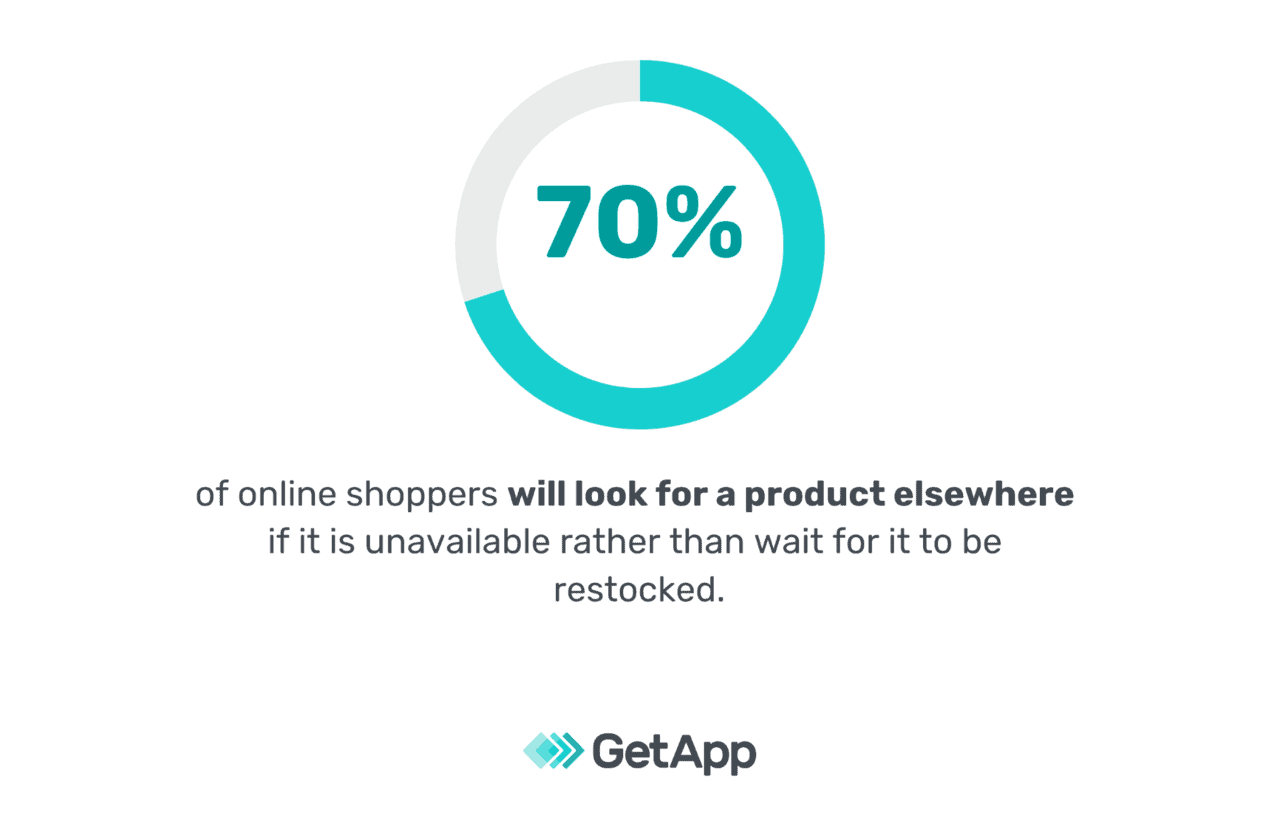Effective inventory management is crucial to the logistics of any retail operation, whether you sell in a single store or have a thriving global, multi-channel company.
Today, most product-selling business owners understand the importance of inventory management and how it might affect their bottom line. Poor inventory management, for example, may result in an oversupply of undesirable goods or the unavailability of regularly in high-demand commodities.
Product turnover in stores that adopt smart inventory management may increase.
So, what does all of this mean?
In a nutshell, it means that their products will not collect dust on warehouse shelves.
Inventory management allows you to keep track of your inventory to not disappoint your consumers with out-of-stocks, inventory shortages, or waste money on excess inventory.
A study from Harvard Business Reviews also reported that around 71,000 consumers worldwide show little patience for stock-outs.
Wait, not just one.
This is quite scary, as Forbes also reported that- Walmart employees lost around $13 million out of this inventory imbalance issue.
I totally understand that fact as maintaining and controlling inventory manually in several locations, i.e., some stock in a store, other products in your store, and others in a warehouse, can be quite challenging. Inventory management can sometimes become a tough ask.
So, what’s the solution then?
Simple, adapting automated centralizing inventory solutions for your business.
Centralizing inventory is one way for retailers to keep track of what’s on hand, what’s leaving, and what’s coming in.
Let’s take a look at the concept, how it might help your business, and the steps you can take to begin centralizing your own operations to determine whether centralizing your inventory is the right move for you.
Before we go too far ahead of ourselves, why not review some of the fundamentals beforehand?
So, let’s get started.
What does Centralized Inventory Stand For?
When a corporation maintains a single hub that manages inventory in the primary location, it is referred to as centralized inventory. Essentially, this strategy concentrates on managing everything that comes and goes through a single, enormous warehouse.
While several warehouse portions are used to store various things, everything is stored under one enormous warehouse roof. All inventory is kept in the same location and is handled by the same individuals using the same transportation techniques. This decreases the number of variables that affect inventory management.
What are Some Impeccable Advantages of Using a Centralized Inventory System?
Getting your products to your customers on schedule is the lifeblood of your business. Keeping track of the inventory and managing it effectively also aids in meeting demand and increasing sales.
We’ll go through some of the most prevalent centralizing inventory benefits here.
- Because all of the inventory is kept in one place, there is more uniformity among the warehouse workers. Furthermore, the logistics and shipping businesses that make deliveries and the workers who do the stocktake are all in the same location; when everything is managed in the same location, there is consistency and regularity.
- However, when there are numerous warehouses, personnel may receive different training, or the functioning of one location may not run as well as the other. Businesses can obtain better control and transparency over their processes by using a centralized inventory approach.
- When everything is controlled from a single location, a task like stocktaking becomes substantially easier. It reduces the number of errors caused by poor or improper communication from other warehouse locations. Instead, there’s only one spot to monitor and double-check numbers.
When you combine this with inventory management systems that can track goods flow in and out, you’ve got a winning combo.
Who Is Likely to be Benefitted from Such a System?
The advantages extend to management, employees, the supply chain, and customers. The uniformity allows management to communicate with employees more effectively.
For example, they can train their employees more effectively because they just have to show them how to execute one form of stocktake in one warehouse rather than different ways in numerous locations. Because the supply chain will have a single consistent delivery point, shipping logistics to customers will be quick and efficient.
Are you sure this system suits well with your business type?
Centralizing inventory has various advantages, but the magnitude of these advantages will vary depending on your specific business procedures and requirements.
Let’s discuss who are the ones to be benefitted more.
Retailers Online
Centralized inventory will benefit retailers with only a few eCommerce channels or a single brick-and-mortar location the most. They face fewer logistical issues than other businesses with many channels because they are primarily concerned with packing and shipping. Ecommerce automation further streamlines these processes, ensuring smoother operations and allowing retailers to focus on core business strategies.
Retailers with a Brick-Mortar Stores
Centralized inventory improves operational efficiency. Retailers with physical stores will be able to ensure that the entire business is looking at the same stock instead of guessing how many of a given product is in another warehouse with a single place for all goods. Inventory management will also improve inventory visibility for the entire team.
There are no disparities in inventory data for physical store owners, allowing them to make informed business decisions.
Multichannel Merchants
There are many more things to consider in a multichannel retail firm as retailers struggle to maintain data in-sync across channels. Implementing a centralized inventory model allows everything to be processed from a single location, eliminating the possibility of double selling or merchandise being sold through another channel.
How Would You Make Your Inventory More Organized?
If you’ve decided to centralize your inventory, there are a few things to keep in mind while you make the change.
Locate the Appropriate Inventory Management Software
To begin, you’ll need to install an inventory management system that allows you to centralize your inventory automatically without major manual involvement.
There is multiple software support available to assist you with inventory control systems, stock managing systems, pos, etc.
Every retailer is attempting to strike a careful balance between having enough inventory and not overstocking. The disadvantages of being understocked are obvious: clients will not receive the product they desire and are unlikely to return.

Overstocking, on the other hand, can also result in negative cash flow, investment finance linked to products, and even concerns with a distribution center or warehouse space.
Therefore, how could we determine which approach is most appropriate for addressing the problem?
Fundamentally, I recommend incorporating an efficient POS System for your retail inventory. Retailers can ensure that they perform inventory control with the most up-to-date real-time information, timing purchases with greater accuracy, and projecting stock requirements across the board by using the correct point of sale software for inventory management.
Centralizing inventory is key to maintaining efficiency and reducing operational challenges, especially in the restaurant industry. Implementing the best restaurant pos system can help streamline inventory tracking, prevent stock shortages, and ensure seamless order management, ultimately improving both business performance and customer satisfaction.
When your stock levels reach the appropriate threshold, orders are automatically sent out, and valuable company details, such as billing and tracking information, are communicated from the back-end all the way to the front-end of the supply chain.
So, how do you believe about the predicament?
If the facts presented above haven’t persuaded you, check out this astonishing statistic from Statista.

One of the most important factors is the inventory issues they face. Inventory management, whether at your business, a warehouse, or a third-party fulfillment company, may be a difficult task. Using a point-of-sale system eliminates guessing and manual errors. A point-of-sale system can assist you in ensuring that you have enough products in the right place at the right time.
Isn’t that wonderful?
Without a doubt. Choose MWB Point of Sale (POS) for WooCommerce without hesitation. It’s a fantastic point-of-sale system that has sparked a market revolution. Store owners with multi-channel inventory systems and those who are still new to the internet and only operate in brick-and-mortar locations can make good use of the system.

The great aspect is that it is a stand-alone plugin that provides you with a great single-page web app with only a few minor configurations. You can use the POS panel to handle orders at many retail counters at the same time.
Because the POS dashboard is totally automated and built on React JS, it does not need to be refreshed regularly.
All the details about installation, setup, and configuration are mentioned in the plugin documentation. It will make your job easier.
Here? If you’re still waiting for a second thought, set it aside and try to decipher the bigger picture that lies underlying. Then make an informed decision.
If you’re still uncertain about this recommendation, let’s discuss this some more.
Why Should You Invest in a Store Inventory Management System?
Using pen and paper or spreadsheets to track stock will quickly become obsolete in a retail operation. Retail inventory management software automates administration and documentation, improves customer experience, lowers costs, and reveals significant patterns.
Among the advantages are:
- Receiving and shipping records that are up to date
- Inventory counts that are accurate and updated in real-time
- Traceability of goods using barcodes or RFID
- Returns have been simplified.
- Improved forecasting
- KPIs are used to measure performance.
- Insights into current sales trends
- Promotions and discounts can be implemented more easily.
- Dynamic and strategic pricing is supported.
- Unique notifications
- Report creation is simple.
Without an automated solution, controlling inventory in an eCommerce, multichannel, or omnichannel business is nearly impossible.
So, what’s next?
Moving Forth With Inventory Centralization…
Retailers who want to stay ahead of the competition and deliver business results through technological innovation rethink how their IT departments are organized.
So, how frequently should inventory audits be conducted?
Again, the answer is determined by your specific business needs. Some stores only do audits once a year, whilst others may perform them monthly. If you’re having difficulty managing your inventory, you should probably increase the frequency until you figure out what’s wrong and how to repair it.
According to Young-Sterling, “an experienced warehouse manager can also help with the shift to centralized inventory. She advises that finding a qualified replacement be a top priority.”
How do you manage inventory in your retail store? Do you believe a centralized inventory system would benefit you? Do let us know in the comments.



